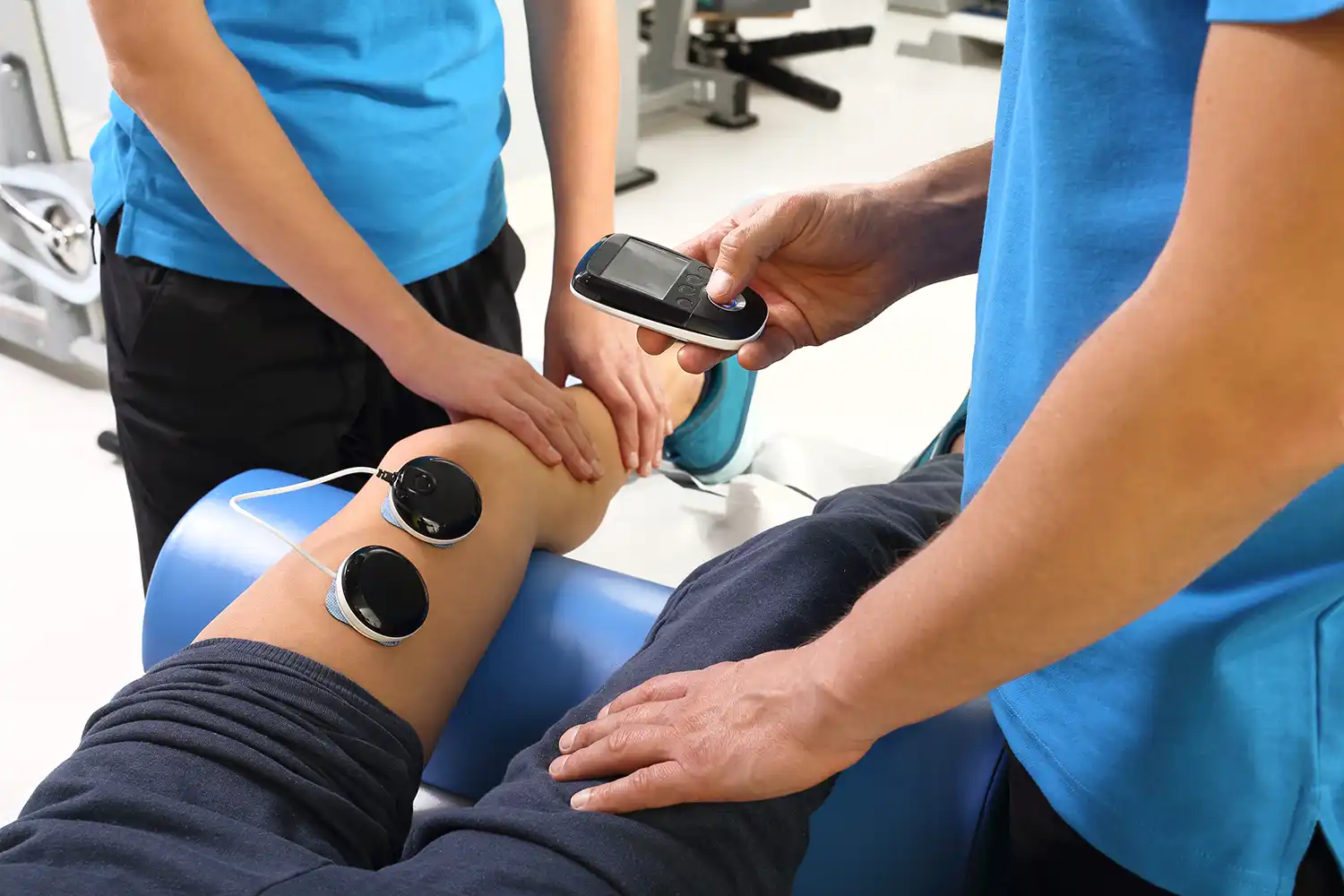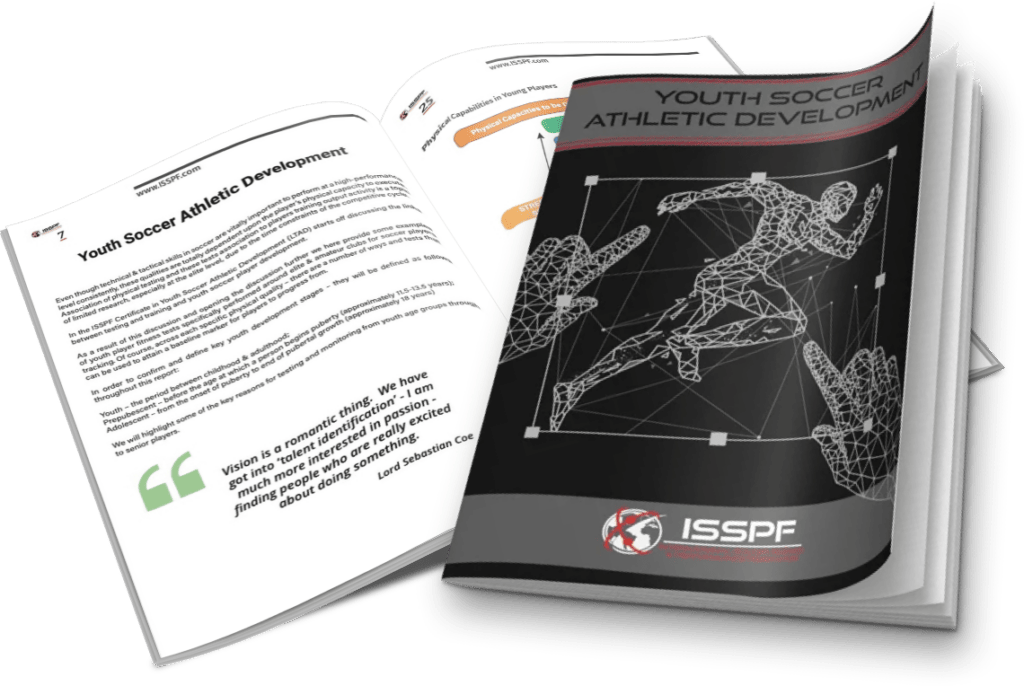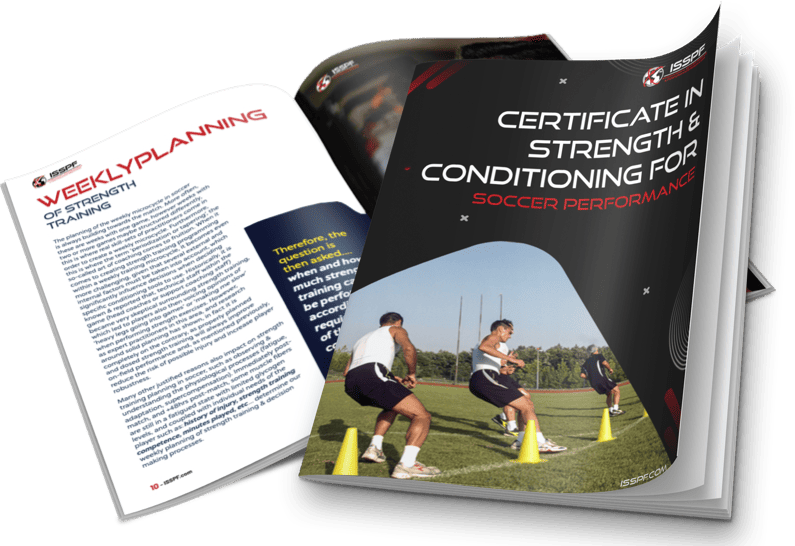Periodisation for Soccer: Optimizing Training Microcycles and Tapering Strategies
Written By: Anton Matinlauri (Los Angeles Football Club, Head of Strength & Conditioning)
Periodisation in soccer training involves dividing the season into specific periods, each with a unique focus on training and recovery (Bomba & Haff, 2009; Issurin, 2010). This report examines the key topics of increased work at the beginning of the training microcycle and the tapering strategy towards the game, aiming to enhance player performance and reduce the risk of injury.
The document will discuss the principles behind periodisation, the rationale for increased workloads, and the importance of tapering for peak performance during match days.
Physical Training and Soccer Methodology Course
Soccer, often referred to as the beautiful game, stands as one of the world’s most beloved and physically demanding sports.
The sport’s dynamic nature calls for players to possess an impressive array of skills, ranging from enduring stamina to explosive strength, lightning-fast speed, and exceptional agility (Reilly, 2005; Dolci et al., 2020). Achieving excellence on the soccer field demands a comprehensive and systematic approach, one that goes beyond raw talent and innate abilities.
This is where periodisation steps into the spotlight as an indispensable tool, skilfully utilized by coaches and trainers to optimize player performance and unlock their full potential.
Periodisation, in essence, is an artful and scientific method, meticulously designed to structure and synchronize training throughout the entire soccer season (Issurin, 2010; Smith & Norris, 2012).
It goes beyond merely assembling a series of practice sessions and matches; instead, it entails a carefully orchestrated journey aimed at developing players’ physical, technical, tactical, and mental attributes in a harmonious and progressive manner.
By strategically dividing the season into distinct phases, coaches and trainers can align training goals with the team’s overarching objectives, ensuring that players peak at precisely the right moments and thrive during pivotal match days.
The multifaceted demands of soccer require players to be well-rounded athletes. Endurance forms the backbone of their performance (Raiola & D’Isanto, 2016), enabling them to tirelessly cover ground, engage in prolonged high-intensity efforts, and maintain a constant presence on the field. Concurrently, strength becomes a vital component, empowering players to hold their ground, shield the ball, and execute powerful shots and headers (Suchomel et al., 2016).
Moreover, speed and agility are prized assets if being able to apply in game like situation (Jeffreys et al., 2018). Allowing players to outpace opponents, react swiftly to changes on the field, and evade defenders with nimble footwork.
In the quest for excellence, coaches and trainers recognize that each player is unique, with distinct strengths and areas for improvement. This realization prompts them to employ periodisation as a tailored approach, catering to individual needs within the collective framework of the team.
Thus, players receive targeted training sessions and specialized exercises, honing their strengths and addressing weaknesses, ultimately fostering a well-balanced and cohesive squad. Furthermore, the art of periodisation extends well beyond physical attributes (Mujika et al., 2018). A soccer match is as much a mental battle as it is a physical one. Psychological preparedness, mental resilience, and tactical acumen are pivotal elements that can define success on the field (Oliveria, 2004).
As such, periodisation takes into account the players’ mental well-being, integrating psychological training and team-building exercises to forge a united and determined mentality.
Principles of Periodisation
The periodisation model involves dividing the season into distinct phases: macrocycle (the entire season), mesocycles (several weeks to months), and microcycles (individual weeks). Each phase is designed to address specific training goals and achieve peak performance at the right time (Issurin, 2010; Smith & Norris, 2012; Reilly, 2005; Dolci et al., 2020).
Macrocycle – The Entire Season:
The macrocycle represents the entirety of the soccer season, typically spanning several months, from pre-season preparation to post-season recovery.
(Reilly et al., 2005; Smith & Norris, 2012; Cissik, 2019) Each country and league may have different structure, thus altering the structure of the macrocycle. Coaches and trainers set long-term objectives for the team and individual players during this phase. They outline the general direction of the training program, highlighting key competitions, and aligning the training goals with the team’s strategic objectives.
Mesocycles – Several Weeks to Months:
Within the macrocycle, the season is further divided into mesocycles, which typically last for several weeks to months.
Each mesocycle has a specific focus and training emphasis, targeting particular aspects of physical, technical, tactical, and mental development. (Cissik, 2019; Morgans et al., 2014) For instance, a mesocycle might prioritize building aerobic endurance, improving attacking patterns, or enhancing recovery strategies.
In pre-season, mesocycles may be more stable in planning with variable targets being set in long term planning. However, in-season periodization may often require more weekly adjustments instead of long term planning, as previous game, next opponent and the results of matches can fluctuate training preparation. Off-season provides the opportunity for macrocycle design from purely physical perspective.
Mesocycles are designed to build upon one another, gradually progressing players towards their peak performance. As each mesocycle unfolds, coaches assess the team’s progress and adjust training priorities based on individual and collective needs.
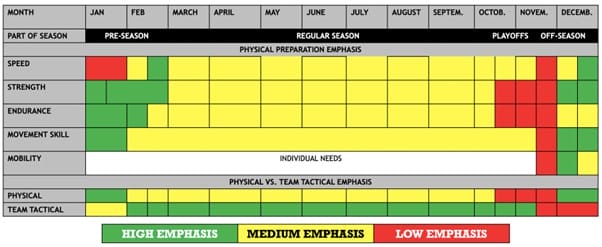
Microcycles – Individual Weeks:
The smallest and most detailed units of the periodisation model are the microcycles, typically spanning one week breaking into individual sessions (Cissik, 2019; Morgans et al., 2014; Delgado-Bordonau & Mendez-Villanueva) Microcycles allow coaches to plan the daily training sessions and closely monitor the players’ workload and recovery with taking into account weekly needs in regards to previous and upcoming game.
In microcycles, training sessions are carefully structured to achieve specific training goals within the context of the broader mesocycle objectives. For example, a microcycle leading up to an important match might include tactical drills, set-piece routines, and recovery sessions.
However, one should note that microcycle involving 1 game a week would look very different from a cycle involving 2 or up to 3 games. With more games being involved in the week, most of training session being forced to focus on players well being from recovery standpoint to be able to perform at their highest level multiple times per week. In this text, a microcycle of 1 game per week will be addressed.
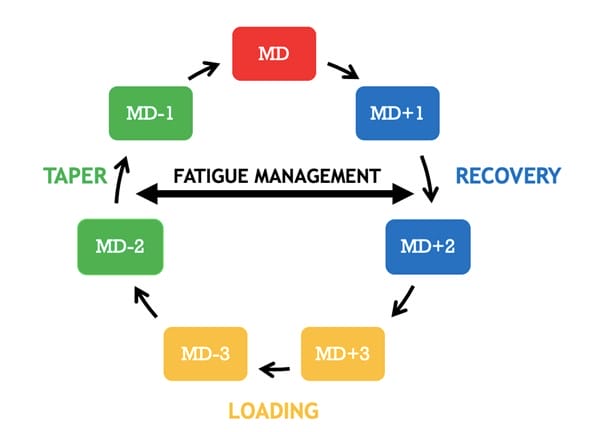
Recovery and Compensatory Training at the Initial Phase of Training Microcycle
After a match, it may take up to 48-72 hours for players to fully recovery from a 90- minute match (Ispirlidis et al., 2008). Therefore, the initial phase of the microcycle is often dedicated to recovery, which can include a recovery sessions and potentially a day off. This period also highlights the importance of substitute players, that often needs compensatory loading to maintain match fitness (Los Arcos et al., 2017)
Increased Work at the Middle of the Training Microcycle
After the initial phase of recovery in the training microcycle, players undergo a phase of higher workloads during the middle part of the cycle (Los Arcos et al., 2017). This period is often known as the “accumulation phase.” The primary goal is to improve general conditioning, build endurance, and increase overall fitness levels.
Endurance and Aerobic Conditioning
Players engage in aerobic exercises, such as distance running, to develop a solid aerobic base. This helps increase oxygen utilization, enhance cardiovascular efficiency, and delay the onset of fatigue during matches (Helgerud et al., 2001).
Strength and Conditioning
Strength training plays a crucial role in this phase as development and retainment of high athleticism is often crucial in soccer (Turner & Stewart, 2014). Focusing on compound movements and functional exercises helps improve overall strength, power, and injury resilience.
Speed training
Speed training from both linear and change of direction perspective play important role in on-field performance of players. Change of direction training is important part of developing robust players with ability to cope with the multilinear nature of the game (Emmonds et al., 2019). Linear speed training has gained a lot of interest from hamstring and posterior chain muscular development and injury prevention perspective as the modern game tends to have higher demands in high speed running and sprinting (Lahti et al., 2020).
Skill Refinement
Though the emphasis is on physical conditioning, skill development is not neglected. Players engage in tactical drills and technical exercises to refine their game-related skills. (Oliveira, 2004; Cissik, 2019).
Tapering Strategy towards the Game
As the match day approaches, players transition into the “peaking phase” or the tapering period. This critical strategy is an essential component of periodisation and is meticulously planned to optimize player performance on the field.
During this phase, coaches and trainers employ a carefully orchestrated approach, gradually reducing training intensity and volume while ensuring players maintain their overall fitness levels (Los Arcos et al., 2017).
The primary goal of this phase is to ensure that players are at their absolute best – fresh, mentally sharp, and physically prepared – for the upcoming match, giving them the competitive edge needed to succeed.
Tapering is a delicate balance between providing adequate recovery for players to recuperate from the cumulative stresses of training and maintaining enough training stimuli to prevent detraining or loss of performance gains (Mujika et al., 2018; Iaia et al., 2009).
By reducing training load, players’ bodies can recover fully, allowing any micro-injuries or muscle fatigue to heal and minimizing the risk of overuse injuries. Moreover, during this phase, players undergo active recovery sessions, light drills, and exercises that help maintain their sharpness and fine-tune their skills without inducing fatigue.
In addition to the physical aspects, the tapering period also addresses the psychological and emotional readiness of the players. Soccer is not solely a physical sport; it demands mental fortitude and focus (Oliveria, 2004).
Therefore, coaches emphasize mental preparation during this phase, engaging players in visualization techniques, motivational talks, and team bonding activities to foster a positive and unified mindset.
The tapering periods duration may vary based on individual player needs, the significance of the upcoming match, and the length of the preceding training intensity. Typically, this phase lasts from a few days to a week, with coaches making real-time adjustments depending on players’ responses and the team’s overall readiness.
One crucial aspect of the tapering strategy is open communication between coaches and players. Players’ feedback is invaluable during this phase, allowing coaches to assess individual readiness and adjust training plans accordingly.
Some players may require more rest, while others might thrive on a slightly higher training load leading up to the match. By acknowledging and accommodating these differences, the coaching staff can maximize the team’s collective potential.
Furthermore, the tapering strategy extends beyond the training ground. Nutrition and recovery play a pivotal role in this phase. Proper hydration, balanced nutrition, and adequate sleep are emphasized to aid players in reaching their peak physical condition. (Malone et al., 2018). Players are encouraged to adopt healthy lifestyle habits to support their bodies during this critical period.
Reduced Training Volume
During tapering, players experience a reduction in training volume (Los Arcos et al., 2017). This means shorter training sessions with a focus on game-related drills and maintaining match-specific fitness.
Preserving High-Intensity Training
Even though the overall workload decreases, players engage in high-intensity training to maintain their sharpness and match readiness.
Mental Preparation
The tapering phase also involves mental preparation, focusing on strategy, tactics, and visualizing performance during the game. (Oliveria, 2004; Delgado – Bordonau & Mendez-Villanueva, 2012)

Benefits of Periodisation for Soccer
The periodisation model offers several advantages (Robertson & Joyce, 2018)
- Injury Prevention
Gradually increasing workloads during the accumulation phase and providing adequate rest during tapering helps reduce the risk of overuse injuries.
- Performance Optimization
Maximize the opportunity for players to reach their peak performance levels during critical stages of the season, such as playoffs or important matches.
- Long-Term Development
Periodisation allows for long-term player development, ensuring players’ fitness and skills progress over time.
Conclusion
In conclusion, periodisation is a vital tool in the arsenal of soccer coaches and trainers. It optimizes player performance by strategically managing training microcycles, starting with increased workloads during the accumulation phase and tapering towards peak performance during the game.
Understanding and implementing effective periodisation strategies are essential for success in modern soccer.
Maximise your Soccer Coaching Potential with the ISSPF Physical Training and Soccer Methodology Course
Are you ready to take your soccer coaching skills to the next level? Look no further!
The International Soccer-Specific Performance & Fitness (ISSPF) is thrilled to present the Physical Training and Soccer Methodology Course, a comprehensive program designed to elevate your coaching prowess and propel your team to victory. Whether you’re a seasoned coach or just starting in the world of soccer coaching, this course is your gateway to success.
Why Choose the ISSPF Physical Training and Soccer Methodology Course?
At ISSPF, we understand the dynamic and ever-evolving nature of soccer coaching. Our course isn’t just about theories; it’s about practical insights that get results on the field. With a unique focus on both physical training and soccer methodology, this course equips you with the knowledge and tools to create a winning team.
What’s Inside the Course?
- Advanced Training Techniques: Discover cutting-edge training methodologies that enhance players’ strength, agility, and endurance. From fitness drills to injury prevention strategies, this course covers it all.
- Tactical Proficiency: Gain deep insights into soccer strategies, player positioning, and game tactics. Learn how to analyze matches, adapt your game plan, and make real-time decisions that outwit your opponents.
- Player Performance Assessment: Understand how to assess your players’ strengths and weaknesses effectively. Tailor your coaching to maximize individual and team performance, and watch your players flourish.
- Interactive Learning: Our online platform offers a rich and interactive learning experience. Engage with fellow coaches, participate in discussions, and access a wealth of resources that you can implement right away.
- Expert Faculty: Learn from accomplished coaches and soccer experts who have a proven track record in producing successful teams and players. Benefit from their real-world experiences and gain insights that can’t be found in textbooks alone.
Are you ready to transform your coaching career? Don’t miss this golden opportunity to enrol in the ISSPF Physical Training and Soccer Methodology Course.
Elevate your coaching strategies, boost your team’s performance, and position yourself as a top-tier soccer coach. Visit our official website to secure your spot today.
Join the Ranks of Elite Soccer Coaches with ISSPF!
References (click + to expand)
References:
- Reilly T. An ergonomics model of the soccer training process. Journal of sports sciences. 2005 Jun 1;23(6):561-72.
- Smith, D.J. and S.R. Norris, in Encyclopedia of Exercise Medicine in health and disease, F.C. Mooren, Editor. 2012, Springer Berling Heidelberg: Berlin, Heidelberg. p. 694-697
- Issurin VB. New horizons for the methodology and physiology of training periodization. Sports medicine. 2010 Mar;40:189-206.
- Kiely J. Periodization theory: confronting an inconvenient truth. Sports Medicine. 2018 Apr;48(4):753-64.
- Bomba, T.O. and G. Haff, Periodization: Theory and methodology of training. 5 ed. 2009, Champaign: Human Kinetics. 411
- Dolci F, Hart NH, Kilding AE, Chivers P, Piggott B, Spiteri T. Physical and energetic demand of soccer: a brief review. Strength & Conditioning Journal. 2020 Jun 1;42(3):70-7.
- Raiola G, D’Isanto T, Assessment of periodization training in soccer. 2016.
- Suchomel TJ, Nimphius S, Stone MH. The importance of muscular strength in athletic performance. Sports medicine. 2016 Oct;46:1419-49.
- Jeffreys I, Huggins S, Davies N. Delivering a gamespeed-focused speed and agility development program in an English Premier League Soccer Academy. Strength & Conditioning Journal. 2018 Jun 1;40(3):23-32.
- Mujika I, Halson S, Burke LM, Balagué G, Farrow D. An integrated, multifactorial approach to periodization for optimal performance in individual and team sports. International journal of sports physiology and performance. 2018 May 1;13(5):538-61.
- Oliveira J. Conhecimento específico em futebol: contributos para a definição de uma matriz dinâmica do processo ensino aprendizagem-treino do jogo. 2004
- Cissik J. Strength and conditioning: a concise introduction. Routledge; 2019 Nov 21.
- Morgans R, Orme P, Anderson L, Drust B. Principles and practices of training for soccer. Journal of Sport and Health Science. 2014 Dec 1;3(4):251-7.
- Delgado – Bordonau L. J., Mendez-Villanueva A., Tactical Periodization: Mourinho’s best-kept secret? 2012.
- Ispirlidis I, Fatouros IG, Jamurtas AZ, Nikolaidis MG, Michailidis I, Douroudos I, Margonis K, Chatzinikolaou A, Kalistratos E, Katrabasas I, Alexiou V. Time-course of changes in inflammatory and performance responses following a soccer game. Clinical journal of sport medicine. 2008 Sep 1;18(5):423-31.
- Los Arcos A, Mendez-Villanueva A, Martínez-Santos R. In-season training periodization of professional soccer players. Biology of sport. 2017 Jun;34(2):149-55.
- Helgerud J, Engen CL, Wisloeff E, Hoff J. Aerobic endurance training improves soccer performance. Med Sci Sports Exerc 33(11): 1925-1931, 2001.
- Iaia FM, Ermanno R, Bangsbo J. High-intensity training in football. International journal of sports physiology and performance. 2009 Sep 1;4(3):291-306.
- Turner AN, Stewart PF. Strength and conditioning for soccer players. Strength & Conditioning Journal. 2014 Aug 1;36(4):1-3.
- Emmonds S, Nicholson G, Begg C, Jones B, Bissas A. Importance of physical qualities for speed and change of direction ability in elite female soccer players. The Journal of Strength & Conditioning Research. 2019 Jun 1;33(6):1669-77.
- Lahti J, Mendiguchia J, Ahtiainen J, Anula L, Kononen T, Kujala M, Matinlauri A, Peltonen V, Thibault M, Toivonen RM, Edouard P. Multifactorial individualised programme for hamstring muscle injury risk reduction in professional football: protocol for a prospective cohort study. BMJ Open Sport & Exercise Medicine. 2020 Aug 1;6(1):e000758.
- Malone S, Owen A, Mendes B, Hughes B, Collins K, Gabbett TJ. High-speed running and sprinting as an injury risk factor in soccer: can well-developed physical qualities reduce the risk?. Journal of science and medicine in sport. 2018 Mar 1;21(3):257-62.
- Oliveira CC, Ferreira D, Caetano C, Granja D, Pinto R, Mendes B, Sousa M. Nutrition and supplementation in soccer. Sports. 2017 May 12;5(2):28.
- Robertson S, Joyce D. Evaluating strategic periodisation in team sport. Journal of sports sciences. 2018 Feb 1;36(3):279-85.
Share this article:







